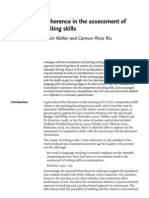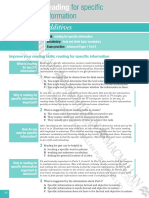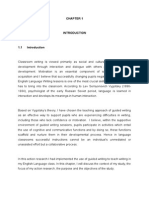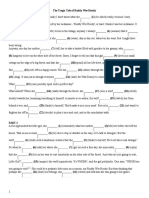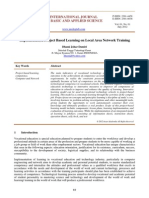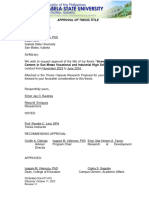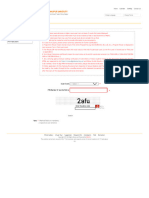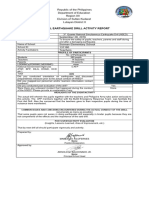Cultural Mirrors: Materials and Methods in English As A Foreign Language
Cultural Mirrors: Materials and Methods in English As A Foreign Language
Copyright:
Available Formats
Cultural Mirrors: Materials and Methods in English As A Foreign Language
Cultural Mirrors: Materials and Methods in English As A Foreign Language
Original Title
Copyright
Available Formats
Share this document
Did you find this document useful?
Is this content inappropriate?
Copyright:
Available Formats
Cultural Mirrors: Materials and Methods in English As A Foreign Language
Cultural Mirrors: Materials and Methods in English As A Foreign Language
Copyright:
Available Formats
INTERNATIONAL JOURNAL OF BASIC AND APPLIED SCIENCE
Insan Akademika Publications
P-ISSN: 2301-4458 E-ISSN: 2301-8038 Vol. 01, No. 01 July 2012
www.insikapub.com
Cultural Mirrors: Materials and Methods in English as a Foreign Language
Dian Ekawati1 and Fakry Hamdani2
Faculty of Education and Teacher Training State Islamic University of Sunan Gunung Djati, Bandung Jl. A. H. Nasution No. 105, Bandung-INDONESIA dian_ekawati_a@yahoo.co.id Faculty of Education and Teacher Training State Islamic University of Sunan Gunung Djati, Bandung Jl. A. H. Nasution No. 105, Bandung-INDONESIA fakry80@gmail.com
2 1
Key Words
Culture, Material, EFL
Abstract
This study tries to review the role of culture in the textbooks and methods used in the classroom. With the documentation and observation as the center of data, the study also tries to arise students awareness of the target culture. The study found that some EFL (English as a Foreign Language) textbooks and EFL methods did not reflect not only the target culture, but also source culture and international culture. Thus, the students and teacher could experience the cultural mismatch. However, the cultural mismatch aroused from different culture of learning between teacher and students or between students and textbooks can be handled by ethnographic stance and explicit teaching
2012 Insan Akademika All Rights Reserved
Background
It is obvious that the teaching of English should consider both language and its culture. Brown (1994) states that whenever we teach a language we also teach a complex system of cultural customs, values, and ways of thinking, feeling and acting. Parallel to Brown, Brooks in Valdes (1986) supports that assumption by saying that the teacher must relate language to culture if a coordinate system is to result from the learners efforts. Here, the culture of the language plays an important role in educational language excellence. In addition, according to Cahyana in Pikiran Rakyat (2001), textbook will directly and indirectly lead to the quality of educational system. However, there cannot be faithful representation of the culture in the Englishlanguage teaching materials or textbooks that the EFL teachers are teaching. The textbooks, generally, only present the international uses of the language but they, actually, should include the aspects of the target culture or in other words the elements of the culture. Therefore, in this chapter, we will analyze some textbooks that figure culture of the English language, highlight the difference between cultural content and cultural medium that we call it culture of learning, and evaluate the textbooks for cultural elements. The culture embedded in the textbooks cannot be separated from the culture of learning because the medium for learning used in the classroom is a part of culture of learning. Its culture of learning is an indicator of knowing the learning process in the classroom that will lead to possible misunderstanding or mismatch
53
International Journal of Basic and Applied Science, Vol 01, No. 01, July 2012, pp. 53-59
Ekawati and Hamdani
between culture in the textbooks and culture of learning that used by teachers or students to acquire the knowledge, skills, or attitudes about the target culture. It is assumed that learning foreign language is only mastering the object of academic study whereas it is for learning a means of communication. Thus, it is recognized that language learning and learning about target cultures cannot be separated (Valdes, 1986; Robinson, 1988; Byram, 1989; Harrison, 1990; Kramsch, 1993a). It is very important to include culture in the textbooks in order to arise students awareness of the target culture. EFL method also reflects culture of learning. Thats why the writer is interested in presenting the cultural mirrors in the textbooks and methods used in the classroom.
Language Teaching and Intercultural Competence
As stated above, language learning and learning about target culture cannot be separated. Byram in Hinkell (1999) shares that foreign language teaching show three broad aims which should be integrated in the process of teaching and learning of foreign language. The aims are: the development of communicative competence for use in situations the learner might expect to encounter; the development of awareness of the nature of language and language learning; the development of insight into the foreign culture and positive attitudes toward foreign people. Culture, in fact, consists of various elements. Some experts define culture in many ways. Culture in broad sense, according to Valette in Valdes (1986), has two major components. One is anthropological or sociological culture: the attitudes, customs, and daily activities of the people, their ways of thinking, their values, and their frames of reference. The other component of culture is the history of civilization. Traditionally representing the culture element in foreign language teaching, it includes geography, history, and achievement in sciences, social sciences, and the arts. This second component forms the framework for the first: it represents the heritage of a people and as such must be appreciated by the students who wish to understand the new target culture. In addition, some language teacher use the terms refer to cultural products (e.g. literary works or works of art) and background information (e.g. facts about the history or geography of countries). Moerman in Hinkel (1999) defines culture as a set perhaps a system of principles of interpretation, together with the products of that system. Thus, culture, as a whole, can be seen as the framework of assumptions, ideas, and beliefs that are used to interpret other peoples action, words, and patterns of thinking. However, it is very important for language learner to know the different cultural frameworks, either their own or those of others so that with their knowledge of different culture, the language learners can adapt themselves in learning the language as well as the culture of it. Hinkel (1999) analyses that communicative competence consisting of grammatical, sociolinguistic, discourse, and strategic competences seems insufficient in relation to the learning. He believes that communicative competence is still too broad while the need of intercultural competence is very urgent here. Intercultural competence defined as the ability of person to behave adequately in a flexible manner when confronted with, actions, attitudes, and expectations of representatives of foreign culture (Meyer, 1991: 137). The learners actually can be aware of this from various media such as TV, multimedia, newspaper etc. Sooner or later, they encounter the member of other cultural groups. In line with this point of view, one would expect the EFL or ESL textbooks reflects a range of cultural contexts and include intercultural elements either in curriculum design or evaluation. Therefore, it is expected that cultural materials on text book will support the students awareness of intercultural issues that enable them to communicate in various communicative context with an appropriate and effective manner.
54
Insan Akademika Publications
Ekawati and Hamdani
International Journal of Basic and Applied Science, Vol 01, No. 01, July 2012, pp. 53-59
Evaluating Textbooks for Cultural Elements Recently, the role of textbooks has extended as follows. 1. a teacher: the textbooks contains the materials that instructs the students about the English speaking cultures. 2. a map: the textbooks give the overview of a structured program. 3. a resource: the textbooks give a set of materials and activities from which the most useful items will be chosen. 4. a trainer: the textbooks guide the an inexperienced teacher and untrained teacher accomplishes step-by step instruction. 5. an authority: the textbooks are valid and written by the expert and carry the authorization of important publishers or minister of education. 6. a de-skiller: the textbook gives the interpretation, critical approach to use the materials as the teacher isnt trained to do. 7. an ideology: the textbooks reflect a worldview or cultural system, a social construction that maybe imposed on teachers and students and construct their perspective of a culture. Also, English textbooks may function as a form of cultural politics. More specifically, Richard (1993) in Hinkell (1999) states, I see textbooks as sourcebooks rather than coursebooks. I see their role as facilitating teaching, rather than restricting it. However in order to be able to serve as sources for creative teaching, teachers need to develop skills in evaluating and adapting published materials. Evaluating the textbooks, now, is a normal part in EFL or ESL teacher training (Hinkel, 1999). The usual way to do this is by getting the teacher to examine textbooks based on the evaluative checklists
Textbook Evaluation Checklists Since there are some textbooks do not include culture in their publications, it is useful for us to know in what ways the materials involve learners values, attitudes, and feelings. Cunningsworths list (1984) tries to see the cultural content of the textbooks from cultural skill as well as cultural knowledge perspectives. It is intended to check whether a cultural setting is acceptable to learners, whether culture is only for the linguistic materials, and whether the cultural contexts help learners in perceiving and categorizing social situations they may find themselves in. Cunningsworth encourages teachers to ask whether the social and cultural contexts are interpretable by students because he argues that language textbooks are bound to express some social and cultural values. Supporting the former, Byrams list specifies on cultural content. He examines evaluating the treatment of cultural content in language textbooks. Meanwhile, Risager (1991) used the same criteria to examine elementary EFL textbooks used in Scandinavia. She found that in the social and geographic definition of textbook characters, the people featured are predominantly middle-class, young people, isolated individuals who are often tourists or visitors to urban centres. They engage in trivial linguistic interaction in mainly leisure activities or consumer situations. They reveal few feeling or opinions and never engage in social, moral, or philosophical problems. The table below will show the Byrams list:
www.insikapub.com
55
International Journal of Basic and Applied Science, Vol 01, No. 01, July 2012, pp. 53-59
Ekawati and Hamdani
Criteria for textbook evaluation
Focus on cultural content Social identity and social groups (social class, regional identity, ethnic minorities) Social interaction (differing levels of formality; as outsider and insider) Belief and behaviour (moral, religious beliefs; daily routine) Social and political Institution (state institution, health care, law and order, social security)
Figure 1. Criteria for Text Book Evaluation
Evaluating Treatment of Cultural Content in Textbooks
Giving factually accurate and up-to-date information Avoiding (relativizing) stereotypes by raising awareness Presenting realistic pictures Being free from (questioning) ideological tendencies Presenting phenomena in context rather than an isolated facts Explicitly relating historical material to contemporary society
Figure 2. Evaluating treatment of cultural content of textbooks
Textbooks Based on Source Cultures There are EFL textbooks produced at a national level for particular countries mirror the source culture (rather than target culture) so that the source and target culture are identical. For example, a textbooks for Venezuela and Turkey. The textbooks have a text describing the countrys chief geographic of Venezuela or the food and history of Turkish. The implication is that students learn English to talk to the visitors who come to the country. They may talk to the visitor by using their own culture; they dont become aware of their own cultural identity. However, people should have intercultural communication. Intercultural communication is defined as an effective identity negotiation process in novel communication episodes, or demonstrated ability to negotiate mutual meanings, rules, and positive outcomes. Now, why do people use source culture? The reason is that it can help students their own cultural identity, deprives learners that identity. Then the result is students cannot engage in intercultural negotiation with a text portraying another culture, unable to engage in dialog with the text to identify and confirm their own cultural identity, or ascertain the differences and similarities with another culture By having this type of communication it is expected that they will cope with the situation and the teacher who has the role as mediator, mediates the textbook in classroom interaction, indicating which aspects the source culture would be interesting or problematic for TL speaker. But it demands intercultural knowledge, skills, and awareness of teacher.
56
Insan Akademika Publications
Ekawati and Hamdani
International Journal of Basic and Applied Science, Vol 01, No. 01, July 2012, pp. 53-59
Textbooks Based on Target Culture There are large number of books focus on target culturesocial, commercial values in order to promote awareness of gender, environmental issues etc. For example, elementary school textbooks which are marketed worldwide portrayed a multicultural nature of American societyhusband as being responsible for child care and house work, while their wives are breadwinners. Another example is in social issue such as child abuse, students are asked to give opinions and comments. From this, we divide the texts into two: closed-text and open-text. Closed-text provides unproblematic world that confirms or reinforces learners views and beliefs. While open-text invites possible interpretation, elaborations, and learners responds such as slavery issues in America.
Textbook Aimed at International Target Culture This kind of textbooks include a wide variety of cultures set in English speaking countries or in a country where English not a first and second language but used as international language. International target culture means that English is used in international situation by the speaker who do not speak as first language, For example Belgian teacher taught Chinese people and they learn it in order to have the ability to talk to Germany and Italian engineering. This book offers interesting culture mirror, the learning of culture and the development of intercultural skills depend in large part on how the textbooks are used in the classroom, the quality of interaction between students, texts, and teachers.
Culture Learning as Dialogue Culture learning through textbook is a process of dialogue in which students negotiate the meaning and identity with the author of the textbook and its cultural content. Here, the role of teacher is as mediator and manager of the way students see the culture mirror in the textbooks and also as a ambassador of culture. Then, a three party-dialogue with the culture content comes when the textbook is used in classroom interaction. The result shows that source cultures dominate the interaction, so that culture content becomes filtered or distorted by the participants approach to interaction with the text.
The Implication for Language Teaching Textbook with different approach of learning seems to be difficult if the teacher and learners still do not have cultural awareness. For example, Chinese students expect western teacher to explain the textbooks while they learn it with attentive listening because the teacher is regarded as an authority and provider of knowledge while western teacher expects Chinese students to be active, hard working, well-motivated etc. Then, they have negative view of each others culture. This cultural mismatch can be avoided by teaching culture in the classroom. Teaching culture is conducted through: textbooks have cultural content. teacher and student should have ethnographic stance toward cultural content and methodology to develop cultural awareness: being aware of members of another cultural groups: their behaviour, expectation, perspectives and values. more textbooks which include explicit intercultural elements. teacher help students to understand the culture of their own and target culture, how to learn culture. explicit teaching, that is by asking student how target culture member interpret the expression, give situation and let them choose to give cultural consequences they have chosen. By paying attention and doing those points, the cultural mismatch could be avoided or reduced so that successful learning can be reached.
www.insikapub.com
57
International Journal of Basic and Applied Science, Vol 01, No. 01, July 2012, pp. 53-59
Ekawati and Hamdani
Similar Research Findings Fearey and Lalor in English Language and Culture in Soviet Textbooks, as cited in (Harrison, 1990) found ideology is set out all levels of education including the textbooks. The pursuance of political goals education in both Soviet and English classroom is strongly influencing the presentation of subject matter. The product is technically excellent, even outstanding but linguistic success frequently prevents the students from realising how much the substance and reality of the culture is absent from his awareness, especially modern idiom terms. The tragedy is that their knowledge, cannot be backed by depth of cultural understanding. Curtain and Pesola in Savignon (1988) proposed some criteria for evaluating textbooks and other printed materials when they examined materials used in Spanish, German, English-speaking classrooms. They investigated whether culture is integrated into the program materials or not, whether the emphasis of the program is on experiencing culture rather than on learning that culture, whether culture is presented from global perspective rather than focussing on a single country, region, or ethnic group, whether the situations and language presented are culturally authentic, or whether the materials promote an appreciation of the value and richness of cultural diversity or not. They found that materials (1) did not reflect the insight of communication and language acquisition, (2) are not completely transferable to elementary school foreign language classroom, (3) developed for the children of guest workers in Germany or the children of German-speaking families living abroad are often too advanced and proceed too rapidly when they used with American speakers of English. Those findings show that there are still a lot of textbooks that do not have cultural content and result from mismatch between the learners and the textbooks especially their cultural understanding.
Conclusion
EFL textbooks reflect not only the target culture, but also source culture and international culture. EFL methods or cultures of learning also reflect culture. It is very crucial to learn culture because without it the students and teacher could experience the cultural mismatch. However, the cultural mismatch aroused from different culture of learning between teacher and students or between students and textbooks can be handled by ethnographic stance and explicit teaching. Regarding to this kind of condition, it is very urgent to teach culture in the classroom especially when we teach foreign language (and also second language). Bear in your mind that when we teach culture, do not teach the students culture explicitly but implicitly so that students will infer the culture by themselves and there is not time-consuming. By doing so, we hope then, the cultural mismatch will be avoided either by students or by the teachers.
References
Brown, H. D.. (1994). Teaching by Principles: An Interactive Approach to Language Pedagogy. Prentice Hall Regents, New Jersey. Cahyana, H. G. (2001). Reposisi Textbook Pendidikan Tinggi. Pikiran Rakyat. February, 24. Granesia, Bandung. Hinkel, E. (1999). Culture in Language Teaching and Learning. Cambridge University Press, Cambridge. Savignon, J. S. (1988). Languages and Children; Making the Match. Company, New York. Addison-Wesley Publishing
58
Insan Akademika Publications
Ekawati and Hamdani
International Journal of Basic and Applied Science, Vol 01, No. 01, July 2012, pp. 53-59
Valdes, M. (1986). Culture Bound: Bridging the Cultural Gap in Language Teaching. Cambridge University Press, Cambridge.
www.insikapub.com
59
You might also like
- Semi-Detailed Lesson Plan in TLE 8-Beauty Care (Nail Care)Document3 pagesSemi-Detailed Lesson Plan in TLE 8-Beauty Care (Nail Care)Francis Joseph Del Espiritu Santo80% (15)
- Certificat Europass MobilityDocument4 pagesCertificat Europass MobilityvladinxyzNo ratings yet
- Clasa A X-A - Scoala - 2014-2015 Subiect&BaremDocument4 pagesClasa A X-A - Scoala - 2014-2015 Subiect&BaremFlorinela PopaNo ratings yet
- Worksheet - Viii - Conditional Clause: I. Match The Two Halves of The SentencesDocument2 pagesWorksheet - Viii - Conditional Clause: I. Match The Two Halves of The SentencesFLORENTINA MIHALACHE100% (1)
- Rawdon Wyatt Check Your English Vocabulary For Living in The UK (Dragged)Document1 pageRawdon Wyatt Check Your English Vocabulary For Living in The UK (Dragged)Adelina D. AnghelNo ratings yet
- Balanced Opinion Essay PDFDocument1 pageBalanced Opinion Essay PDFsumita gargNo ratings yet
- About Languages of EuropeDocument9 pagesAbout Languages of EuropeAlexandr VranceanNo ratings yet
- Programa in Engleza B1Document21 pagesPrograma in Engleza B1elenaNo ratings yet
- Outline For Explanatory Synthesis EssayDocument1 pageOutline For Explanatory Synthesis EssayJn90No ratings yet
- Marking Scheme For English TestDocument3 pagesMarking Scheme For English TestNely BroascaNo ratings yet
- Bản Sao Của Discourse Analysis & Intercultural CommunicationDocument171 pagesBản Sao Của Discourse Analysis & Intercultural CommunicationmeomautrangNo ratings yet
- Sample Unit - Grade 1 Secondary Education - Components in Table Per Session - DMFDocument36 pagesSample Unit - Grade 1 Secondary Education - Components in Table Per Session - DMFAlper Aslan100% (1)
- Delta Module One - Reading List - 2022-23Document4 pagesDelta Module One - Reading List - 2022-23Samia AnwarNo ratings yet
- British Culture - QuizDocument2 pagesBritish Culture - QuizMartin SketchleyNo ratings yet
- Lee - Cognitive Development in Bilingual ChildrenDocument24 pagesLee - Cognitive Development in Bilingual ChildrenGeorge AlexandrescuNo ratings yet
- Coherence in The Assessment of Writing SkillsDocument11 pagesCoherence in The Assessment of Writing SkillsPatricia CarrilloNo ratings yet
- C1 Advanced Reading and Use of English Part 8: Teacher's NotesDocument7 pagesC1 Advanced Reading and Use of English Part 8: Teacher's NotesOlha Sen'kivNo ratings yet
- NecessitiesDocument5 pagesNecessitiesapi-350988968No ratings yet
- FOOD ADDITIVES ImproveAdvancedReadingDocument8 pagesFOOD ADDITIVES ImproveAdvancedReadingemysameh100% (2)
- Lead Vak TestDocument1 pageLead Vak TestnifftytwiktNo ratings yet
- CHAPTER 1using Guided Writing To Teach Year 6 Writing ClassDocument13 pagesCHAPTER 1using Guided Writing To Teach Year 6 Writing Classqueenie772002No ratings yet
- Task 5 EssayDocument1 pageTask 5 EssayJon SierraNo ratings yet
- Summary of Discourse Analysis For LanguaDocument18 pagesSummary of Discourse Analysis For LanguaFaizFaidhurrahmanNo ratings yet
- Christmas in Great BritainDocument18 pagesChristmas in Great Britain12345No ratings yet
- Module 10 Whats The MatterDocument18 pagesModule 10 Whats The Mattersikuna100% (1)
- Tkt:Clil: Learning Skills Across The CurriculumDocument10 pagesTkt:Clil: Learning Skills Across The CurriculummelotooleNo ratings yet
- Letter of Application CAEDocument8 pagesLetter of Application CAEAleksandra Spasic100% (1)
- Subiecte Situatii Neincheiate-Cls. A 12aDocument6 pagesSubiecte Situatii Neincheiate-Cls. A 12aAlina PoenaruNo ratings yet
- Syllabus Business English and FunDocument10 pagesSyllabus Business English and FunEra B. LargisNo ratings yet
- Stay Hungry Stay FoolishDocument8 pagesStay Hungry Stay FoolishGabi OrbanNo ratings yet
- Fce Test 6Document5 pagesFce Test 6Kevin Laura De la Cruz0% (1)
- Presentation Structure Hamburger ModelDocument4 pagesPresentation Structure Hamburger ModelCabin VectorNo ratings yet
- Essential Academic English B2 PDFDocument2 pagesEssential Academic English B2 PDFMaria MeryNo ratings yet
- Reading Comprehension - First CertificateDocument5 pagesReading Comprehension - First Certificatecorazon_salvaje100% (1)
- WEEK 12 Materials Selection, Adaptation and SimplificationDocument37 pagesWEEK 12 Materials Selection, Adaptation and Simplificationraathigaa2677100% (1)
- Questionnaire English VersionDocument8 pagesQuestionnaire English VersionvalentinaperNo ratings yet
- The International Corpus of Learner EnglishDocument10 pagesThe International Corpus of Learner EnglishAzam BilalNo ratings yet
- Phonetic Chart Landscape American English PDFDocument1 pagePhonetic Chart Landscape American English PDFquynh ngoc100% (1)
- BRITLIT Using Literature in Efl ClassroomsDocument81 pagesBRITLIT Using Literature in Efl ClassroomsNova Lingga PitalokaNo ratings yet
- Using Games To Enhance Oral Communication in Upper Primary SchoolDocument15 pagesUsing Games To Enhance Oral Communication in Upper Primary SchoolAzizan ShafieNo ratings yet
- Metodica Sfaturi PDFDocument25 pagesMetodica Sfaturi PDFjohnyNo ratings yet
- Literature in The Language ClassroomDocument6 pagesLiterature in The Language ClassroomInternet GhoulNo ratings yet
- The Tragic Tale of Ruddy Wee HoodyDocument6 pagesThe Tragic Tale of Ruddy Wee HoodyUros Vasovic100% (1)
- ELT - Material - Resources From IHDocument2 pagesELT - Material - Resources From IHZahid HossainNo ratings yet
- British Culture and Civilisation - IspitDocument15 pagesBritish Culture and Civilisation - IspitHelix NebulaNo ratings yet
- ZappDocument14 pagesZappSuhanto Kastaredja100% (1)
- Snowball Descriptive WritingDocument4 pagesSnowball Descriptive Writingascd_msvuNo ratings yet
- Competente Engleza 2015Document8 pagesCompetente Engleza 2015MarianaPricopNo ratings yet
- DIGITAL Resources For Teachers and Learners 2018 To ShareDocument21 pagesDIGITAL Resources For Teachers and Learners 2018 To ShareEddy Tudor100% (1)
- ENGLISH SHTEM - 3 2017-18 - Unlocked PDFDocument304 pagesENGLISH SHTEM - 3 2017-18 - Unlocked PDFԴավթաշենի Համակարգչային ԾառայություններNo ratings yet
- Teaching Pragmatics of GreetingsDocument10 pagesTeaching Pragmatics of Greetingsابو محمدNo ratings yet
- British Culture and Civilisation First Year - Licence First SemesterDocument62 pagesBritish Culture and Civilisation First Year - Licence First SemesterWidade MestariNo ratings yet
- Sound Advice For Language LearnersDocument3 pagesSound Advice For Language LearnersMihnea BaloiNo ratings yet
- Festivals Lesson Plan c1 DocumentDocument10 pagesFestivals Lesson Plan c1 DocumentPenciuc AlexNo ratings yet
- Developing Reading Com PDFDocument10 pagesDeveloping Reading Com PDFAnDreez CamphozNo ratings yet
- Course Syllabus: College: Program: EducationDocument7 pagesCourse Syllabus: College: Program: EducationGel Obenza BunedNo ratings yet
- Vocabulary 1 - Living A Healthy LifeDocument3 pagesVocabulary 1 - Living A Healthy LifeLoris Maffei100% (1)
- 37-46 NazarDocument10 pages37-46 NazarAnnisaNo ratings yet
- Analysis of New Concept English From The Perspective of Cross-Cultural Communication-A Case Study in Book 2Document8 pagesAnalysis of New Concept English From The Perspective of Cross-Cultural Communication-A Case Study in Book 2Abdulkader TukaleNo ratings yet
- Global Materials Versus Local Materials For Students' Reading Comprehension: A Library ResearchDocument3 pagesGlobal Materials Versus Local Materials For Students' Reading Comprehension: A Library Researchmkooty zabaryNo ratings yet
- 4315 9326 1 SMDocument7 pages4315 9326 1 SMViolet BeaudelaireNo ratings yet
- A.C Electrical Conductivity For Polyaniline Prepered in Different Acidic MediumDocument11 pagesA.C Electrical Conductivity For Polyaniline Prepered in Different Acidic MediumInternational Journal of Basic and Applied ScienceNo ratings yet
- Using LabVIEW: Simulation Exciter of Devices JammingDocument11 pagesUsing LabVIEW: Simulation Exciter of Devices JammingInternational Journal of Basic and Applied ScienceNo ratings yet
- Recent Trends in Wage and Salary Administration in Nigeria: A Synopsis On Theoretical and Empirical ChallengesDocument12 pagesRecent Trends in Wage and Salary Administration in Nigeria: A Synopsis On Theoretical and Empirical ChallengesInternational Journal of Basic and Applied Science100% (1)
- 11IJBASDocument5 pages11IJBASFernandes Uhuy'No ratings yet
- 13ijbas PDFDocument6 pages13ijbas PDFandi2rNo ratings yet
- Overpopulation Literature ReviewDocument13 pagesOverpopulation Literature Reviewapi-33916691167% (3)
- Tips On How To Retell A Story: 1 2 3 4Document1 pageTips On How To Retell A Story: 1 2 3 4Xbass StiffNo ratings yet
- Trade UnionDocument22 pagesTrade UnionMuskan GulwaneyNo ratings yet
- Tutorial Week 2: List Down The Strengths and Weaknesses of The Teaching Materials DiscussedDocument5 pagesTutorial Week 2: List Down The Strengths and Weaknesses of The Teaching Materials DiscussedTeo Khim SiangNo ratings yet
- Laney College Catalog 2011 2013Document312 pagesLaney College Catalog 2011 2013AblePraxisNo ratings yet
- m14 Math Listening ExerciseDocument2 pagesm14 Math Listening ExerciseLuthfiyana Dian ArshifaNo ratings yet
- Yulia Cartseva Brenner School: Lesson Plan #4 Level: Elementary, 4 GradeDocument5 pagesYulia Cartseva Brenner School: Lesson Plan #4 Level: Elementary, 4 Gradejkartseva2No ratings yet
- Letter For Culminating Activity P.EDocument6 pagesLetter For Culminating Activity P.EAngel Joan MarasiganNo ratings yet
- Anup Iti ResumeDocument3 pagesAnup Iti ResumermeckotaNo ratings yet
- Schoollist2019 20Document265 pagesSchoollist2019 20Hardik PatelNo ratings yet
- 2020 21 First Aid Webinar Questions and AnswersDocument4 pages2020 21 First Aid Webinar Questions and AnswerssamtaloNo ratings yet
- PR1 - Sampling Methods 1Document5 pagesPR1 - Sampling Methods 1Jose OrbeNo ratings yet
- Syllabus TypesDocument6 pagesSyllabus TypesMerbai MajdaNo ratings yet
- DID101Document66 pagesDID101Rakesh ChandraNo ratings yet
- Cbse XiDocument385 pagesCbse XishaannivasNo ratings yet
- SAQRF Final DocumentDocument21 pagesSAQRF Final DocumentKrishanRajapakseNo ratings yet
- Research Form EducDocument7 pagesResearch Form EducElmer BautistaNo ratings yet
- English-Weekly-Prototype-LP-Eng8-Q2-Week 7Document4 pagesEnglish-Weekly-Prototype-LP-Eng8-Q2-Week 7Emmanuel Jess AguilarNo ratings yet
- Jee Result PDFDocument2 pagesJee Result PDFSukNo ratings yet
- Rashtrasant Tukadoji Maharaj Nagpur UniversityDocument1 pageRashtrasant Tukadoji Maharaj Nagpur Universityfgod60321No ratings yet
- Milestone 2 GtsDocument4 pagesMilestone 2 Gtsapi-349908048No ratings yet
- 3rd EARTHQUAKE DRILL ACTIVITY REPORTDocument3 pages3rd EARTHQUAKE DRILL ACTIVITY REPORTFlorence TangkihayNo ratings yet
- A1 Movers 2018 Listening Part 3 PDFDocument13 pagesA1 Movers 2018 Listening Part 3 PDFTrang ĐỗNo ratings yet
- Management Mybook: SampleDocument15 pagesManagement Mybook: SampleGAURAV KUMARNo ratings yet
- Punjabi University, Patiala: M.Phil / Ph.D. Application-Cum-Entrance Test Form-I 2012-2013Document4 pagesPunjabi University, Patiala: M.Phil / Ph.D. Application-Cum-Entrance Test Form-I 2012-2013Harkulvinder SinghNo ratings yet
- Chapter 1 (Mabel1)Document14 pagesChapter 1 (Mabel1)jaime15.moradaNo ratings yet
- Theory Into Practice: Click For UpdatesDocument12 pagesTheory Into Practice: Click For UpdatesBERNARD RICHARD NAINGGOLANNo ratings yet
- Narrative IpcrfDocument2 pagesNarrative IpcrfEjm Izobelle CabarlesNo ratings yet
- Cs Brain Break BrochureDocument2 pagesCs Brain Break Brochureapi-313064117No ratings yet















